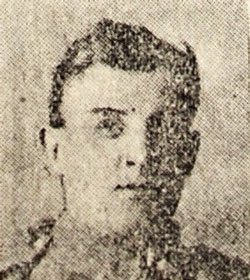Private Thomas Burrows

Thomas Burrows (or Burrowes) was born on 5 March 1888 at Drumaghadone, Dromore, County Down, the second of seven children of farm labourer (later motorman), James Burrows and his wife Matilda (née Clarke). By the time of the 1911 Census he was living at 27 Belmont Avenue, Belfast, with his parents and five of his siblings, and working as a gardener. They later moved to nearby Halstein Drive.
Burrows enlisted in the North Irish Horse between 11 and 30 December 1914 (No.1359). He trained at the regiment's Antrim reserve depot before embarking for France on 17 November 1915 with F Squadron, which at the time was serving as divisional cavalry to the 33rd Division.
In June 1916 F Squadron combined with C Squadron and the 6th (Inniskilling) Dragoons Service Squadron to form the 2nd North Irish Horse Regiment, serving as corps cavalry to X Corps until August-September 1917, when the regiment was disbanded and its men were transferred to the Royal Irish Fusiliers, an infantry regiment. Most, including Burrows, were transferred on 20 September and posted to the 9th (Service) Battalion – renamed the 9th (North Irish Horse) Battalion – joining it in the field at Ruyaulcourt five days later. Burrows was issued regimental number 41226 and posted to D Company (another record says A Company).
Burrows was one of the many posted as missing following the 9th (NIH) Battalion's fighting withdrawal from St Quentin from 21 to 28 March 1918 during the German spring offensive. It was later learned that he had been captured on 27 March at Erches, near Roye, when much of the battalion had been overwhelmed by the fast-moving German advance. He remained a prisoner until the end of the war, held at camps including Stendal in Germany.
Burrows arrived in England from Germany on 28 November 1918. He was demobilised and transferred to Class Z, Army Reserve, on 2 April 1919. Later that year he was granted a pension due to myalgia, which was attributed to his military service.
Following his discharge Burrows returned to Halstein Drive and resumed work as a gardener. On 16 February 1921 he married Agnes Anderson at the Strand Presbyterian Church, Belfast. He was allocated one of the ex-servicemen's houses at St Quentin Park, Glengormley. Agnes died at the Royal Victoria Hospital on 5 July 1939, and Thomas on 9 December 1960. They are buried in the Corner Graveyard at Carnmoney Parish Church (Plot H8/1).
Image from the Ballymena Weekly Telegraph, May 1918, and much of the information on Burrows' life after the war, courtesy of Nigel Henderson of History Hub Ulster.
This page last updated 20 December 2023.
